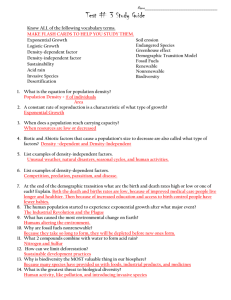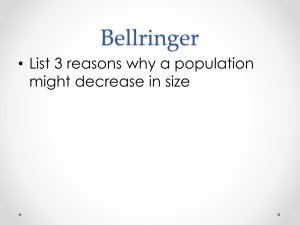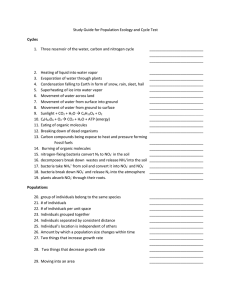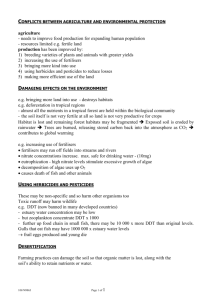COVER WORK TASK A: Go to powerpoint from last lesson 2.7
advertisement
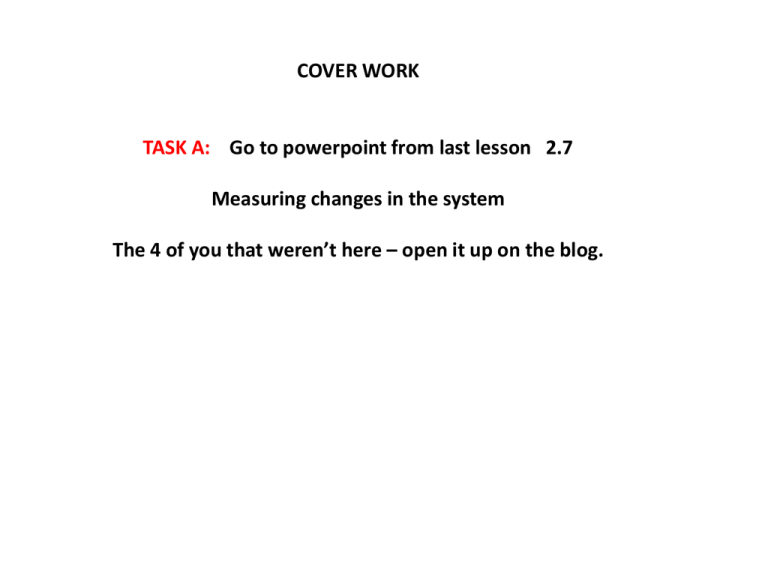
COVER WORK TASK A: Go to powerpoint from last lesson 2.7 Measuring changes in the system The 4 of you that weren’t here – open it up on the blog. Intensive agriculture and effects on a nearby stream Google images of intensive agriculture. Find images to make a collage on this page. You must include: Pesticides being sprayed All land being used – no space Machinery being used Irrigation (watering) of crops Greenhouses What is intensive agriculture? Intensive farming practices include growing high-yield crops, using fertilisers and pesticides and keeping animals indoors. Food production is increased but there are unwelcome side effects. Using this definition and the photos, use a few words only to say how can intensive farming candamage a nearby stream. 1. Machinery such as tractors use diesel which... 2. Fertilisers will... 3. Pesticides will... Find out what eutrophication is and what effect it has on plant life in ponds – algae and large plants – and on fish. Algae: Other plants: Fish: So, you need to be able to describe and evaluate methods for measuring changes in abiotic and biotic components of an ecosystem due to a specific human activity. (2.7.2) i.e. say how the pollution from the farm is affecting the stream If one farm was causing the pollution to the nearby stream mark on two places where you would do your tests . Stream Farm How would you test for fertilisers/pesticides? How would you test for biotic factors (animal and plant life)? TASK B: DENSITY-DEPENDENT AND DENSITY-INDEPENDENT FACTORS These are two types of factor that control the population size. Density dependent factors happen when you have large populations; they don’t affect small populations. Density independent factors control the population regardless of how many are in the population. disease Is a tsunami density dependent or density-independent? Why? Is disease usually density dependent or density-independent? Why? Is fire density dependent or density-independent for animals? Why? And for plants? Why? Volcanic eruption: Parasites such as worms: Prey being killed by predators: Drought: Use these words to fill in the next slide. You won’t need all the words. Then delete this slide. tsunamis parasitism volcanic eruptions negative positive density dependent birth death density-independent biotic abiotic Some limiting factors are related to how dense the population is. Some aren’t. …………………………………………………….. factors will control a population size if there is a high population density. They lower the …………………….. rate or raise the ……………………….. rate as the population grows in size. Density dependent factors cause ……………………………………. feedback to occur e.g. ……………………………………………….. will control a population size whether there is a high population density or not. Density independent factors are usually …………………………… e.g. Density-dependent limiting factors can be internal or external Internal factors: Act within a species External factors: Act between species Predation: is it within a species or between species Limited breeding areas: is this a factor that happens within a species of\r between species Disease: does a disease like malaria act within a species or between species? Limited food supply: does this act within a species or between species? Explain how predator-prey relationships control the population size of both the predator and the prey. One paragraph Explain how limited breeding areas controls the population size and leads to a better gene pool. One paragraph One long paragraph: How do density-dependent and density-independent factors, and internal and external factors, regulate populations? Task C: Soil testing IA For this IA all you need to do is: Raw data tables Processed data tables Graphs – pH, potassium, Phosphorus, nitrates, organic, mineral content - Bar charts? Pie charts? Think carefully what the best ones will be. Try not just to use bar graphs again… What you should be able to measure: Mass of the crucible Mass of the crucible + soil + Organic matter + water (before heating) Mass of the crucible + soil + Organic matter (after heating) Mass of the crucible + soil (after burning) What you should work be able to work out: Mass of water Mass of organic matter - GRAPH Mass of mineral content of the soil - GRAPH
